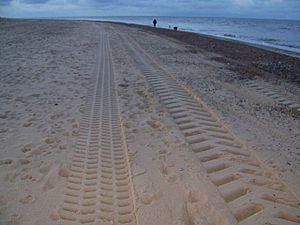Great Yarmouth North Denes facts for kids
| Site of Special Scientific Interest | |
 |
|
| Area of Search | Norfolk |
|---|---|
| Interest | Biological |
| Area | 100.8 hectares (249 acres) |
| Notification | 1992 |
| Location map | Magic Map |
Great Yarmouth North Denes is a very special natural area in Great Yarmouth, Norfolk. It covers about 100.8 hectares, which is roughly the size of 250 football fields! This place is officially known as a Site of Special Scientific Interest (SSSI). This means it's protected because of its amazing wildlife and unique natural features.
It's also recognized as a Nature Conservation Review site and a Special Protection Area. These titles show just how important Great Yarmouth North Denes is for nature. It's a key spot for protecting certain types of plants and animals, especially birds.
Contents
What Makes This Place Special?
Great Yarmouth North Denes is famous for its beautiful beaches and sand dunes. These dunes are not just piles of sand. They are home to a full range of different plant types. You can see everything from plants that grow right on the beach to those found further inland.
The Amazing Dune Habitats
The sand dunes here show a complete "succession" of plant life. This means you can observe how different plants grow as you move away from the sea.
Foredunes: The First Line of Plants
Close to the water, you'll find the foredunes. These are the first small dunes that form. They are home to tough plants that can handle salty air and shifting sand. These plants help to stabilize the dunes.
Dry Acid Dune Grassland: A Rare Habitat
Further away from the sea, the dunes become more stable. Here, you'll find a large area of dry acid dune grassland. This type of grassland is quite rare and very important. It supports many different insects and small animals. The plants here are adapted to sandy, dry, and slightly acidic soil.
Home to the Little Tern
One of the most exciting things about Great Yarmouth North Denes is its bird population. This site has the largest breeding colony of little terns in Britain.
Little Tern Life Cycle and Reproduction
Little terns are small, graceful seabirds. They fly quickly and have a distinctive yellow bill with a black tip. These birds travel long distances to breed here. They lay their eggs directly on the sand or shingle. This makes their nests very hard to spot.
The little terns arrive in spring to find a mate and lay their eggs. Both parents take turns incubating the eggs. Once the chicks hatch, they are very small and camouflaged. The parents work hard to feed them tiny fish. Protecting these nesting areas is super important for the little terns to successfully raise their young.
Why Protection is Important
Because the little terns nest on the ground, their eggs and chicks are vulnerable. They can be disturbed by people, dogs, or even high tides. That's why Great Yarmouth North Denes is so carefully protected. It helps ensure these special birds have a safe place to raise their families.

